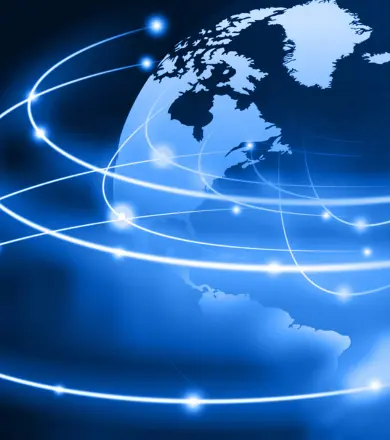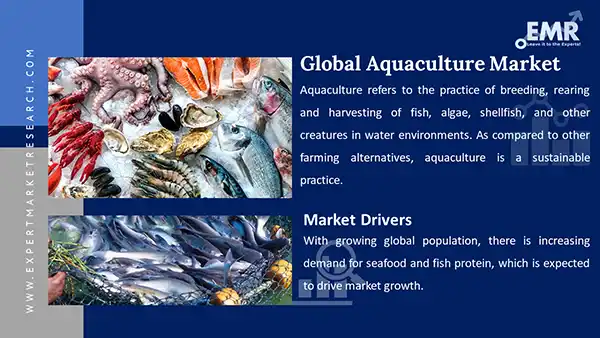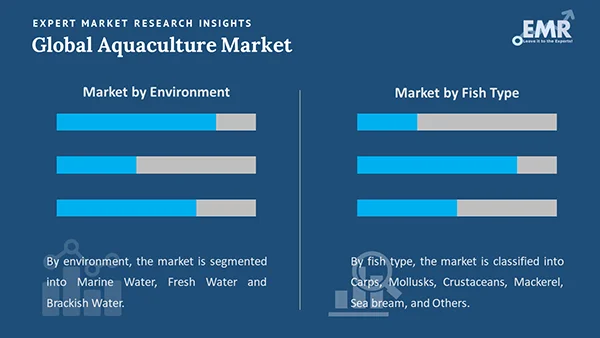
Consumer Insights
Uncover trends and behaviors shaping consumer choices today
Procurement Insights
Optimize your sourcing strategy with key market data
Industry Stats
Stay ahead with the latest trends and market analysis.
Trending Now



The global aquaculture market reached a volume of nearly 87.77 Million Tons in 2024. The market is assessed to grow at a CAGR of 4.10% during the forecast period of 2025-2034 to attain a volume of around 131.18 Million Tons by 2034. The market is being driven by the rising demand for alternative protein, favourable government initiatives, technological advancements and innovations, the growing emphasis on sustainability, expansion of land-based aquaculture, and growing global population.
Base Year
Historical Year
Forecast Year






Value in Million Tons
2025-2034
Aquaculture Market Outlook
*this image is indicative*
| Global Aquaculture Market Report Summary | Description | Value |
| Base Year | Million Ton | 2024 |
| Historical Period | Million Ton | 2018-2024 |
| Forecast Period | Million Ton | 2025-2034 |
| Market Size 2024 | Million Ton | 87.77 |
| Market Size 2034 | Million Ton | 131.17 |
| CAGR 2018-2024 | Percentage | XX% |
| CAGR 2025-2034 | Percentage | 4.1% |
| CAGR 2025-2034 - Market by Region | Asia Pacific | 7.0% |
| CAGR 2025-2034 - Market by Country | India | 7.7% |
| CAGR 2025-2034 - Market by Country | China | 7.3% |
| CAGR 2025-2034 - Market by Environment | Fresh water | 5.0% |
| CAGR 2025-2034 - Market by Fish Type | Crustaceans | 5.1% |
| Market Share by Country 2024 | USA | XX% |
As compared to other farming alternatives, aquaculture is a sustainable practice. Seafood offers high protein retention as compared to chicken, pork, and beef, and has the lowest feed conversion ratio among identical protein forms. Also, as against other farming practices, aquaculture shows lower greenhouse gas emissions, thus affecting the global aquaculture demand growth.
With a growing global population, the demand for animal protein is expected to increase significantly, bolstering the aquaculture industry growth. Emphasis on finding sustainable methods of providing healthy food to the world population is increasing, and under these circumstances, sustainable aquaculture emerges as a good solution. These factors are expected to contribute to market growth.
Governments globally are investing in infrastructure to boost local seafood production, contributing to food security and creating new economic opportunities. For instance, in September 2024, the Indian government announced its focus to increase annual seafood exports to INR 1 lakh crore from around INR 60,000 crore in 2023.

Read more about this report - REQUEST FREE SAMPLE COPY IN PDF
Industry statistics show that, for the year 2024, China leads by a mile with an aggregate fisheries production of 85.95 million tonnes, of which 13.14 million tonnes came from capture fisheries and an enviable 72.81 million tonnes from aquaculture, thereby shaping the aquaculture market dynamics and trends. Such dominance simply underlines how well-developed and extensive aquaculture in China is greatly outnumbering its capture fisheries output.
Aquaculture is experiencing significant growth as a vital component of global fisheries production, underscoring the rising demand for sustainable and efficient fish farming. Indonesia, closely following global leaders, produces 21.81 million tonnes of fisheries output, with 14.61 million tonnes derived from aquaculture and 7.21 million tonnes from capture fisheries, reflecting a strong emphasis on aquaculture expansion. India ranks third globally with 14.43 million tonnes of total fisheries production, where aquaculture contributes 9.41 million tonnes, highlighting the country’s increasing focus on sustainable and high-performance fish farming. Vietnam, producing 8.29 million tonnes overall, balances traditional capture fisheries (3.54 million tonnes) with growing aquaculture activities (4.75 million tonnes). This shift toward aquaculture-driven growth demonstrates its pivotal role in meeting the rising global demand for seafood and supporting sustainable fisheries practices.
Rising demand for alternative protein; expanding land-based aquaculture; growing emphasis on sustainability; and technological advancements are favouring the aquaculture market expansion.
The rising demand for alternative protein and the growing shift towards plant-based, insect-based, and other novel protein sources as alternatives to traditional animal-based proteins like fishmeal are increasing aquaculture market value. Plant-based proteins such as soy, wheat, and pea and insect proteins derived from black soldier fly larvae are significantly gaining popularity due to their lower environmental impact and potential to reduce feed costs. The production of alternative proteins, especially insects, boasts a lower carbon footprint as compared to traditional fishmeal and supports circular economy models. Furthermore, plant-based seafood alternatives offer similar taste and nutritional value to traditional seafood, encouraging aquaculture producers to adopt more sustainable practices in order to meet shifting consumer preferences.
The expansion of land-based aquaculture is creating lucrative aquaculture market opportunities. Land-based aquaculture eliminates issues associated with marine environments such as the spread of diseases, sea lice, and antibiotic resistance. In land-based tanks, natural tides can be replicated, and pumps, filters, and bacteria help keep the water clean. Moreover, land-based aquaculture enables precise control of environmental factors, including salinity, temperature, and water quality. This leads to more efficient growth and reduces stress on the fish, resulting in better-quality seafood. With the growing emphasis on traceability, land-based aquaculture systems are gaining popularity as they provide clearer tracking of production processes, including fish health, water quality, and feed.
Reportedly, feed ingredients are responsible for up to 80% of the aquaculture’s carbon impact and up to 90% of certain environmental impacts like land and water use. Hence, addressing feed sustainability is crucial for lowering environmental challenges such as water and land use. Key players are increasingly adopting alternative feeds, such as insect-based, plant-based, and algae-based options, to reduce pressure on wild fish stocks. In November 2024, the Sustainable Fisheries Partnership (SFP) launched a Feed Solutions Toolkit for the aquaculture industry, combining more than 80 tools, initiatives, standards, and platforms from multiple organisations to support companies make informed and sustainable choices about aquaculture feed. The rise of plant-based and lab-grown seafood alternatives, marketed as sustainable alternatives to traditional aquaculture, is driving the aquaculture market expansion.
Technological advancements aimed at driving the productivity, efficiency, and sustainability of aquaculture are aiding the market. The development of recirculating aquaculture systems (RAS) that enable the farming of fish in land-based, closed-loop systems that reduce the need for external water sources and offer greater control over environmental variables such as temperature and water quality is fuelling the market. Automated feeding technologies are increasingly adopted to increase feed efficiency, ensure optimal feeding, improve fish growth rates, and reduce waste. Moreover, the integration of the Internet of things (IoT), artificial intelligence (AI), and real-time monitoring to optimise feeding, disease management, and water quality is expected to revolutionise the aquaculture market landscape in the coming years.
Sustainable practices, technological integration, and alternative proteins drive efficiency and growth in aquaculture.
Sustainable Practices
Aquaculture is gradually adjusting its practices to environmental-friendly strategies that will minimise the impacts it has on the environment, becoming a key trend of the aquaculture industry For example, the integrated multi-trophic aquaculture and the recirculating aquaculture system acquire these practices to better the resources, waste reduction, and increase sustainability in the operation of fish farming.
Technological Integration
Aquaculture is transformed by advanced technologies: Automation in feeding, real-time sensors for monitoring, genetic improvements—all the way to health, optimised feeding practices, and productivity improvement. Innovations drive efficiency and sustainability in modern fish farming, thus boosting the trends in the aquaculture market.
Changing to Alternative Proteins
There is a growing focus on fish feed made from alternative sources of protein, such as plant-based ingredients and insect meal. This trend aims at minimum reliance on wild-caught fish, thus meeting the sustainability concerns and assurance toward a more sustainable and environmentally friendly way of aquaculture feeds, leading on to new aquaculture market opportunities.
Consumer demand, sustainable practices, innovation, and economic growth fuel market opportunities globally.
Global demand, technological improvements, government support, and efficient breeding drive market growth.
Aquaculture faces environmental, disease, regulatory, climate, economic, and sustainability challenges impacting market growth.

Read more about this report - REQUEST FREE SAMPLE COPY IN PDF
“Aquaculture Market Report and Forecast 2025-2034” offers a detailed analysis of the market based on the following segments:
On the basis of environment, the market can be divided into the following:
On the basis of fish type, the market can be divided into the following:
Based on region, the market can be segregated into:
| CAGR 2025-2034 - Market by | Environment |
| Fresh water | 5.0% |
| Marine water | 4.7% |
| Brackish water | XX% |
| CAGR 2025-2034 - Market by | Fish Type |
| Crustaceans | 5.1% |
| Carps | 4.8% |
| Mollusks | 4.6% |
| Mackerel | XX% |
| Sea bream | XX% |
| Others | XX% |
| CAGR 2025-2034 - Market by | Region |
| Asia Pacific | 7.0% |
| North America | 5.0% |
| Europe | XX% |
| Latin America | XX% |
| Middle East and Africa | XX% |
Aquaculture is expanding in marine, freshwater, and brackish environments to meet global seafood demand.
Aquaculture is gaining popularity in marine, freshwater, and brackish water ecosystems due to diverse opportunities in production and increasing demand for sustainable seafood. As per aquaculture market analysis, aquaculture species are growing in marine, with salmon and tuna mainly from the offshore systems. Freshwater aquaculture is represented by tilapia and catfish, whereby progression is made step by step with more benefits from lower costs and higher production efficiency. Aquaculture of brackish waters, especially shrimp, is on the rise in the coastal region with an emphasis toward environmental responsibility and in achieving global seafood demand.
Aquaculture demand for salmon, tilapia, and shrimp grows due to health, sustainability, and profitability.
Compared to other species, the demand for salmon, tilapia, and shrimps is particularly increasing owing to a high global consumption of seafood, people's higher awareness towards health conditions that derive from seafood, and the culture towards sustainability. Aquaculture for salmon is on an upsurge based on high demand in domestic and export markets. As per aquaculture industry analysis, freshwater species such as tilapia benefit since they are considerably cheap and versatile. Brackish water shrimp farming is continuously gaining because it's more lucrative and exportable, mostly in places like Asia and Latin America where there's fulfilment of local demand but export is from the producing areas.
North America Aquaculture Market Opportunities
The North American aquaculture market is supported by various government initiatives aimed at promoting sustainable seafood production. In the United States, the National Oceanic and Atmospheric Administration (NOAA) has invested in programs like the Seafood and Aquaculture Innovation Fund to improve production and sustainability. The United States Department of Agriculture (USDA) is also supporting aquaculture expansion under its "Aquaculture Development Plan." In Canada, the government’s "Growing Canadian Agriculture" strategy includes support for sustainable aquaculture, with a focus on improving environmental practices and production efficiency.
| CAGR 2025-2034 - Market by | Country |
| India | 7.7% |
| China | 7.3% |
| Japan | 5.9% |
| Canada | 5.7% |
| Australia | 5.6% |
| USA | 4.9% |
| UK | XX% |
| Germany | XX% |
| France | XX% |
| Italy | XX% |
| Saudi Arabia | XX% |
| Brazil | XX% |
| Mexico | XX% |
Europe Aquaculture Market Dynamics
The European aquaculture market is driven by increasing demand for sustainable seafood, stringent environmental regulations, and technological innovations. In Norway, the largest producer of farmed salmon, the industry is focusing on reducing environmental impact through offshore farming and new feed technologies. The EU’s "Farm to Fork" strategy promotes sustainable aquaculture practices across member states. In Spain, Mediterranean aquaculture, particularly fish farming, is growing, with significant government investment in sustainable production methods to meet both domestic and export needs.
Asia Pacific Aquaculture Market Trends
The Asia Pacific aquaculture market is driven by growing seafood demand, technological advancements, and sustainable farming practices. China, the world’s largest aquaculture producer, continues to dominate with innovations in fish farming technologies and feed efficiency. In India, shrimp farming is expanding rapidly due to rising export demand, supported by government initiatives like the Pradhan Mantri Matsya Sampada Yojana (PMMSY). Southeast Asian countries, such as Vietnam and Thailand, are focusing on eco-friendly practices to meet global sustainability standards and increase production.
Latin America Aquaculture Market Insights
The Latin America market for aquaculture is experiencing growth due to increasing seafood demand, favourable climatic conditions, and government support for sustainable practices. For instance, Brazil, the region’s largest producer, has seen significant investment in tilapia and shrimp farming, driven by both domestic consumption and exports. Chile, a global leader in salmon production, continues to innovate with sustainable farming techniques. Governments across the region are promoting aquaculture through subsidies, infrastructure development, and research to boost production and ensure food security.
Middle East and Africa Aquaculture Market Drivers
The Middle East and Africa aquaculture market is significantly influenced by government initiatives aimed at boosting food security and promoting sustainable seafood production. In Saudi Arabia, the government’s Vision 2030 plan emphasises increasing domestic fish production to reduce dependency on imports. The UAE's Ministry of Climate Change and Environment is investing in aquaculture research to enhance sustainable practices. Additionally, Egypt’s government is supporting aquaculture expansion, with plans to produce 2 million tons of fish annually by 2025.
The aquaculture market players are focusing on sustainability and resource efficiency as well as food security. They want to reduce the environmental footprint, increase traceability, and conduct farming responsibly. Innovations in feed technology, disease management, and water quality dominate the list. Aquaculture companies are also investing in digital solutions for better farm management, fostering transparency, and unlocking growing global demand for seafood while adhering to higher sustainability standards.
Cermaq Group AS, established in 1995 and headquartered in Norway, has focused on R&D to enhance the health and welfare of fish by investing in breeds that can resist diseases and adopting novel farming techniques. Automated feeding and health monitoring trigger with the objective of feeding optimization and health management through data analytics and machine learning-farm management solution applications. Cermaq keeps to sustainable aquaculture and pursues best practices that lessen its effect on the environment by improving the well-being of fish.
Strategic purchases and partnerships led to Cooke Aquaculture, founded in 1985 and headquartered in Canada, widening its circle of market existence in North America, amongst other areas. It has done its sustainability growth policy by investing in eco-friendly operations and reducing the footprint of environmental emissions during the production process. Cooke value-added its product offerings by developing further processing of seafood, targeting niche markets, and trying to move toward consumer demand.
Nippon Suisan Kaisha, Ltd. (NISSUI), established in 1937 and headquartered in Japan, has invested in R&D to source quality aquaculture products. It ranges from improvements in breeding technologies and feed formulations. The company adheres religiously to guaranteeing sustainability through environmentally friendly practices and responsible sourcing. Moreover, NISSUI had focused on bases around the world and strategic alliances to gain a broader market presence.
Leroy Seafood Group ASA, headquartered in Bergen, Norway and established in 1899, is a prominent seafood company. The company is engaged in the production of salmon and trout as well as catches of whitefish. Boasting packaging and production plants in Norway, Sweden, Denmark, Finland, France, the Netherlands, Portugal, Spain, Italy, Turkey and Shetland Islands, the company offers an extensive range of sustainable and healthy products in over 80 countries.
*Please note that this is only a partial list; the complete list of key players is available in the full report. Additionally, the list of key players can be customized to better suit your needs.*
Other key players in the aquaculture market report are Alpha Group, Aquaculture Technologies Asia Limited, Marine Harvest ASA, and P/F Bakkafrost, among others.
*While we strive to always give you current and accurate information, the numbers depicted on the website are indicative and may differ from the actual numbers in the main report. At Expert Market Research, we aim to bring you the latest insights and trends in the market. Using our analyses and forecasts, stakeholders can understand the market dynamics, navigate challenges, and capitalize on opportunities to make data-driven strategic decisions.*
Get in touch with us for a customized solution tailored to your unique requirements and save upto 35%!
The market is projected to grow at a CAGR of 4.10% between 2025 and 2034.
The market is estimated to witness healthy growth in the forecast period of 2025-2034 to reach a volume of around 131.18 Million Tons by 2034.
The major market drivers include the global demand for fish protein and aquatic food and also because of aquaculture being a sustainable practice for getting seafood.
The key trends propelling the market growth are having seafood with lower emissions, increasing demand for marine water fish, and a focus on food safety.
The major regions in the aquaculture market are North America, Latin America, the Middle East and Africa, Europe, and the Asia Pacific.
The significant aquaculture environments are marine water, freshwater, and brackish water.
The various applications of aquaculture include Carps, Mollusks, Crustaceans, Mackerel, Sea bream, and others.
The major players in the market are Alpha Group, Aquaculture Technologies Asia Limited, Cermaq Group AS, Cooke Aquaculture, Leroy Seafood Group ASA, Marine Harvest ASA, Nippon Suisan Kaisha, Ltd., and P/F Bakkafrost, among others.
In 2024, the market reached an approximate volume of 87.77 Million Tons.
Explore our key highlights of the report and gain a concise overview of key findings, trends, and actionable insights that will empower your strategic decisions.
| REPORT FEATURES | DETAILS |
| Base Year | 2024 |
| Historical Period | 2018-2024 |
| Forecast Period | 2025-2034 |
| Scope of the Report |
Historical and Forecast Trends, Industry Drivers and Constraints, Historical and Forecast Market Analysis by Segment:
|
| Breakup by Environment |
|
| Breakup by Fish Type |
|
| Breakup by Region |
|
| Market Dynamics |
|
| Competitive Landscape |
|
| Companies Covered |
|
| Report Price and Purchase Option | Explore our purchase options that are best suited to your resources and industry needs. |
| Delivery Format | Delivered as an attached PDF and Excel through email, with an option of receiving an editable PPT, according to the purchase option. |
Datasheet
One User
USD 2,499
USD 2,249
tax inclusive*
Single User License
One User
USD 3,999
USD 3,599
tax inclusive*
Five User License
Five User
USD 4,999
USD 4,249
tax inclusive*
Corporate License
Unlimited Users
USD 5,999
USD 5,099
tax inclusive*
*Please note that the prices mentioned below are starting prices for each bundle type. Kindly contact our team for further details.*
Flash Bundle
Small Business Bundle
Growth Bundle
Enterprise Bundle
*Please note that the prices mentioned below are starting prices for each bundle type. Kindly contact our team for further details.*
Flash Bundle
Number of Reports: 3
20%
tax inclusive*
Small Business Bundle
Number of Reports: 5
25%
tax inclusive*
Growth Bundle
Number of Reports: 8
30%
tax inclusive*
Enterprise Bundle
Number of Reports: 10
35%
tax inclusive*
How To Order
Our step-by-step guide will help you select, purchase, and access your reports swiftly, ensuring you get the information that drives your decisions, right when you need it.

Select License Type
Choose the right license for your needs and access rights.

Click on ‘Buy Now’
Add the report to your cart with one click and proceed to register.

Select Mode of Payment
Choose a payment option for a secure checkout. You will be redirected accordingly.
Gain insights to stay ahead and seize opportunities.

Get insights & trends for a competitive edge.

Track prices with detailed trend reports.

Analyse trade data for supply chain insights.

Leverage cost reports for smart savings

Enhance supply chain with partnerships.

Connect For More Information
Our expert team of analysts will offer full support and resolve any queries regarding the report, before and after the purchase.
Our expert team of analysts will offer full support and resolve any queries regarding the report, before and after the purchase.
We employ meticulous research methods, blending advanced analytics and expert insights to deliver accurate, actionable industry intelligence, staying ahead of competitors.
Our skilled analysts offer unparalleled competitive advantage with detailed insights on current and emerging markets, ensuring your strategic edge.
We offer an in-depth yet simplified presentation of industry insights and analysis to meet your specific requirements effectively.



Australia
63 Fiona Drive, Tamworth, NSW
+61-448-061-727
India
C130 Sector 2 Noida, Uttar Pradesh 201301
+91-723-689-1189
Philippines
40th Floor, PBCom Tower, 6795 Ayala Avenue Cor V.A Rufino St. Makati City,1226.
+63-287-899-028, +63-967-048-3306
United Kingdom
6 Gardner Place, Becketts Close, Feltham TW14 0BX, Greater London
+44-753-713-2163
United States
30 North Gould Street, Sheridan, WY 82801
+1-415-325-5166
Vietnam
193/26/4 St.no.6, Ward Binh Hung Hoa, Binh Tan District, Ho Chi Minh City
+84-865-399-124
United States (Head Office)
30 North Gould Street, Sheridan, WY 82801
+1-415-325-5166
Australia
63 Fiona Drive, Tamworth, NSW
+61-448-061-727
India
C130 Sector 2 Noida, Uttar Pradesh 201301
+91-723-689-1189
Philippines
40th Floor, PBCom Tower, 6795 Ayala Avenue Cor V.A Rufino St. Makati City, 1226.
+63-287-899-028, +63-967-048-3306
United Kingdom
6 Gardner Place, Becketts Close, Feltham TW14 0BX, Greater London
+44-753-713-2163
Vietnam
193/26/4 St.no.6, Ward Binh Hung Hoa, Binh Tan District, Ho Chi Minh City
+84-865-399-124
Share